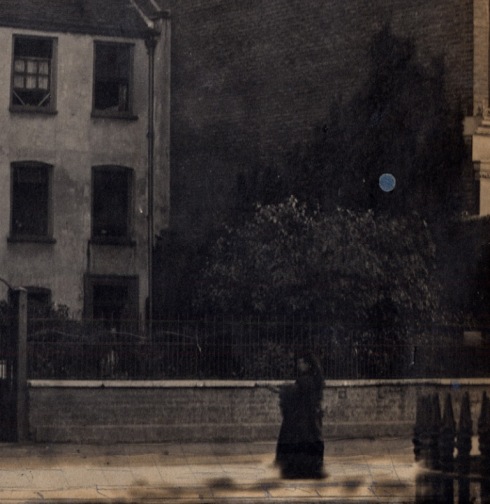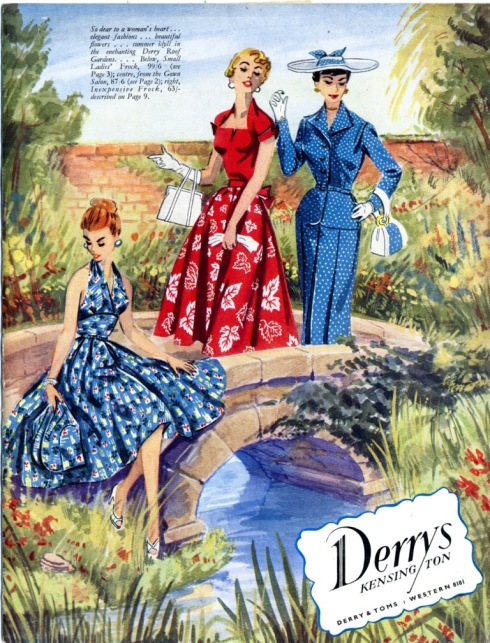At its height the John Barker Company owned all three of Kensington High Street’s great department stores: Barkers itself, Derry and Toms and Pontings and a few other buildings in the area. Two of the store buildings remain as reminders of the great era of department store shopping: the Barker’s building itself, home of Whole Foods, Gap and of course Northcliffe House and the Derry and Toms building, home of M&S and H&M, still surmounted by the Roof Garden. (I won’t attempt to say exactly when that era was, pick your favourite: the 30s, the 50s, the 60s?).
Today’s post takes us back to the 1920s and 1930s to the period before and during the construction of the current Barker’s and Derry and Toms buildings and uses an album of photographs given to the Council by the Company. The whole story of the construction is a long one. You can find a good account of it in the Survey of London which I will not try to compete with. But to summarize: the Company had to acquire all the land it needed and close at least one street for building purposes. The process of the construction of the new Barker’s was interrupted by the building of the new Derry and Toms (1929-1931) which took over the attention of the Company, and later the Second World War during which operations were suspended so the Barkers building wasn’t completed until 1958.
You’ll need a plan to grasp this, but first a picture taken from the corner of Ball Street in October 1924.
This shows Young Street looking north west. The house in the foreground is Thackeray’s house. Next to it is Kensington Square Mansions, the first buildings to be demolished to make way for the new Barkers.
And now the plan:
Carefully colour-coded, as you can see, to show the all the Company’s properties, the three stores, and Ball Street. Young Street has retained its name but King Street is now called Derry Street for obvious reasons.
[It’s well past lunch time so I’m pausing now to get a sandwich and take a quick field trip to the site.] [Back – interesting to see the rear of the two buildings.]
This is also Young Street.
In the centre is the Post Office sorting office, and beside it the entrance to the Bakery and Cooked Meats Kitchens.
This picture shows Ball Street on January 11th 1928, the day the hoarding to close Ball Street was erected.
If we turn north on that same day…
The rear of Ball Street with the ghostly spire of St Mary Abbots Church rising in the distance.
The point of view shifts east in this picture.
This was the first section of the new premises. On the left you can see a temporary bridge over Ball Street.
This is the east side of King Street showing a Derry and Toms building and a door to the old fire station.
The hoarding on the left shows the location of Ball Street.
This is a view of the rear of the west side of King Street with part of Burden Mews (look back at the plan).
Demolition is in progress.
I’ve included this picture of the corner of Burden Mews purely for the convertible. Motoring experts will soon identify it I’m sure.
This is Derry’s Yard, a narrow mews on the west side of Derry and Toms well out of the public eye, with a rough bridge connecting two buildings.
March 1928
More demolition in Burden Mews with a couple of figures in the background exchanging a few words about the work in progress.
Here another group lurk in a doorway perhaps avoiding the camera.
Can you spot another solitary figure below?
A man in a white coat on the first floor.
Back to Ball Street now.
It’s filled with the “covered way”, a temporary structure (man on the roof) and a clearer view of the bridge connecting the old and new buildings.
This is the way it looked from the other direction in October 1929.
The men on the scaffolding are actually posing for this one. The group on the ground are standing by the temporary staff entrance.
Finally, an image from nearly a decade later in July 1938.
This is on the east side of Kensington Square. The Staff Cafeteria is in the centre and the entrance to Lower Yard, where there was a Wine Cellar, a Bonded Cellar and a charging station for electric vehicles. (Ahead of its time?)
The construction of the Barkers building seems to have been a bit of a struggle but even though the stores that were their original purpose are gone, both it and the Derry and Toms building remain as are 20th century classics which have in their way influenced the whole of Kensington High Street.
Postscript
I wanted something to break up a flurry of posts about book illustration so the Trevor Bowen Estate came to the rescue again.









































































